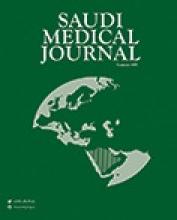Abstract
OBJECTIVE: To test the usability of neutrophil/lymphocyte (N/L) and C-reactive protein/mean platelet volume (CRP/MPV) ratios for the differential diagnosis of bacterial versus viral pneumonia, and the early diagnosis of complications related to pneumonia.
METHODS: This retrospective study was conducted on 31 patients diagnosed with bacterial pneumonia and 21 patients diagnosed with viral pneumonia from January 2011 to December 2012 in the Department of Pediatrics, Faculty of Medicine, Abant Izzet Baysal University, Bolu, Turkey. We investigated the clinical characteristics, radiological, and laboratory findings of patients from their medical records.
RESULTS: The female/male ratio of patients with bacterial was 1.0/1.8, and with viral pneumonias was 1.0/2.0. The mean patient age was 59+/-51 months. There was a statistically significant difference in the neutrophil/lymphocyte ratio (2.7 versus 0.6, p<0.001) and CRP/MPV ratio (11.0 versus 9.3, p<0.001) in the cases with bacterial pneumonia versus those who had viral pneumonia. Nine of the patients were identified as having complications. There was a statistically significant difference in the N/L ratio (3.5 versus 1.2, p=0.01) and CRP/MPV ratio (11.1 versus 3.9, p=0.001) in the cases that developed complications compared with those that did not. When the neutrophil/lymphocyte and CRP/MPV ratios were used jointly, the diagnosis of bacterial pneumonia could be correctly estimated in 28 (90.3%) cases (odds ratio [OR]=0.06, 95% confidence interval [CI]: 0.01-0.29, p<0.001) and pneumonia-related complications were predicted in 8 (88.9%) cases (OR=13.5, 95% CI: 1.5-118.1, p=0.005).
CONCLUSION: It was observed that the combined use of N/L and CRP/MPV ratios might be used in both the differential diagnosis of bacterial versus viral pneumonia, and the prediction of complications.
- Copyright: © Saudi Medical Journal
This is an open-access article distributed under the terms of the Creative Commons Attribution-Noncommercial-Share Alike 3.0 Unported, which permits unrestricted use, distribution, and reproduction in any medium, provided the original work is properly cited.






